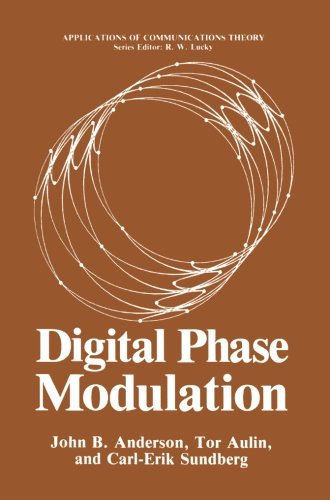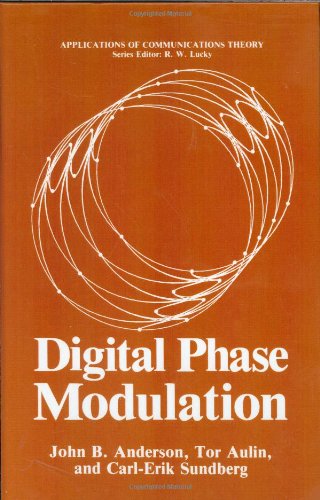Background
Sundberg, Carl-Erik Wilhelm was born on July 7, 1943 in Karlskrona, Sweden. Arrived in United States, 1984. Son of Erik Wilhelm and Martha Maria (Snaar) Sundberg.


(The last ten years have seen a great flowering of the the...)
The last ten years have seen a great flowering of the theory of digital data modulation. This book is a treatise on digital modulation theory, with an emphasis on these more recent innovations. It has its origins in a collabor ation among the authors that began in 1977. At that time it seemed odd to us that the subjects of error-correcting codes and data modulation were so separated; it seemed also that not enough understanding underlay the mostly ad hoc approaches to data transmission. A great many others were intrigued, too, and the result was a large body of new work that makes up most of this book. Now the older disciplines of detection theory and coding theory have been generalized and applied to the point where it is hard to tell where these end and the theories of signal design and modulation begin. Despite our emphasis on the events of the last ten years, we have included all the traditional topics of digital phase modulation. Signal space concepts are developed, as are simple phase-shift-keyed and pulse-shaped modulations; receiver structures are discussed, from the simple linear receiver to the Viterbi algorithm; the effects of channel filtering and of hardlimiting are described. The volume thus serves well as a pedagogical book for research engineers in industry and second-year graduate students in communications engineering. The production of a manageable book required that many topics be left out.
http://www.amazon.com/gp/product/1489920331/?tag=2022091-20

(This book brings you a new approach to designing efficien...)
This book brings you a new approach to designing efficient and robust mobile radio communications links. After introducing the basic concepts of cellular radio and radio links, "Source-Matched Mobile Communications" details the effect of transmission errors on link performance for pulse code modulation (PCM). It describes the interaction between speech coding, channel coding, and modulation for mobile radio links. You'll also find thorough treatment of performance for binary and quadrature amplitude modulation, amplitude weighting of the binary PCM signals, and soft demodulation.
http://www.amazon.com/gp/product/0780311639/?tag=2022091-20

(The last ten years have seen a great flowering of the the...)
The last ten years have seen a great flowering of the theory of digital data modulation. This book is a treatise on digital modulation theory, with an emphasis on these more recent innovations. It has its origins in a collabor ation among the authors that began in 1977. At that time it seemed odd to us that the subjects of error-correcting codes and data modulation were so separated; it seemed also that not enough understanding underlay the mostly ad hoc approaches to data transmission. A great many others were intrigued, too, and the result was a large body of new work that makes up most of this book. Now the older disciplines of detection theory and coding theory have been generalized and applied to the point where it is hard to tell where these end and the theories of signal design and modulation begin. Despite our emphasis on the events of the last ten years, we have included all the traditional topics of digital phase modulation. Signal space concepts are developed, as are simple phase-shift-keyed and pulse-shaped modulations; receiver structures are discussed, from the simple linear receiver to the Viterbi algorithm; the effects of channel filtering and of hardlimiting are described. The volume thus serves well as a pedagogical book for research engineers in industry and second-year graduate students in communications engineering. The production of a manageable book required that many topics be left out.
http://www.amazon.com/gp/product/030642195X/?tag=2022091-20
researcher telecommunications executive
Sundberg, Carl-Erik Wilhelm was born on July 7, 1943 in Karlskrona, Sweden. Arrived in United States, 1984. Son of Erik Wilhelm and Martha Maria (Snaar) Sundberg.
Master of Electrical Engineering, University Lund, Sweden, 1966. Doctor of Philosophy, University Lund, Sweden, 1975.
Teacher, research assistant, lecturer University Lund, 1966-1975, research professor (docent), 1977-1984. Research fellow European Space Agency, Nordwijk, The Netherlands, 1975-1976. Distinguished member technical staff American Telephone & Telegraph Company Bell Laboratories, Murray Hill, New Jersey, 1984-1996, Lucent Technologies, Bell Laboratories, 1997-2000.
With media signal processing research department Agere Systems, 2000—2001, iBiquity Digital, Warren, New Jersey, 2002—2003. Principal, owner SundComm, Sunnyvale, California, since 2003. Consultant L.M. Ericsson, Gothenburg, Sweden, 1976-1977, Bell Laboratories, Crawford Hill, New Jersey, 1981-1982.
Instructor Carl Cranz Gesellschaft, Oberpfaffenhofen, Federal Republic Germany, 1990-1993. Visiting professor Korea University, Seoul, 2003-2005. Served in Swedish Navy, 1968.
(This book brings you a new approach to designing efficien...)
(The last ten years have seen a great flowering of the the...)
(The last ten years have seen a great flowering of the the...)
Fellow Institute of Electrical and Electronics Engineers (Best Paper award 1986, guest editor Journal on Selected Areas in Communications 1988-1989, 2005-2006, 2 papers named among 50 most influential 2002), Institution of Electrical Engineers Marconi Premium (Best Paper award 1989). Member Swedish Union Radio-Scientifique Internat.
